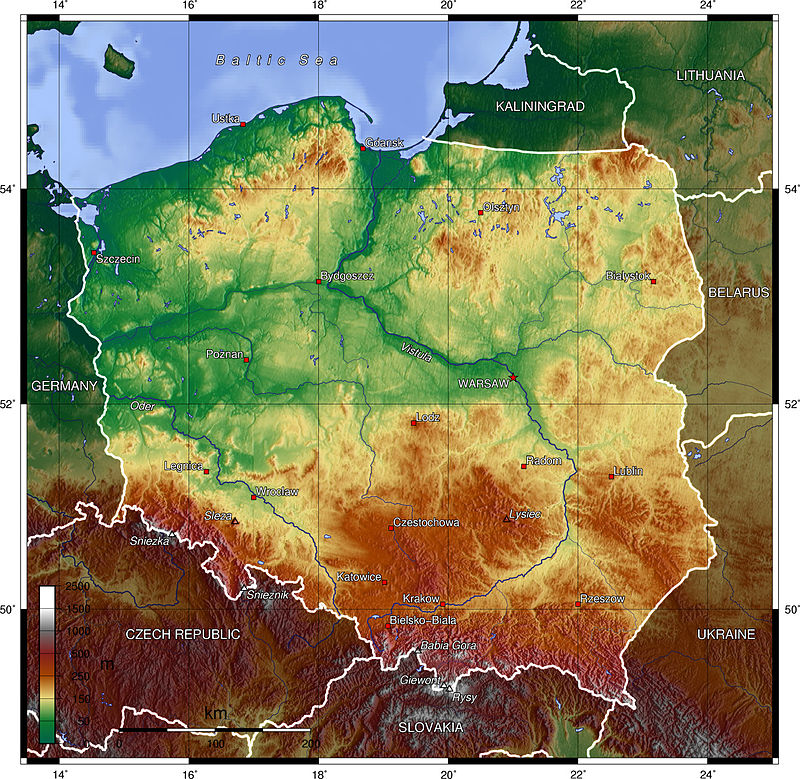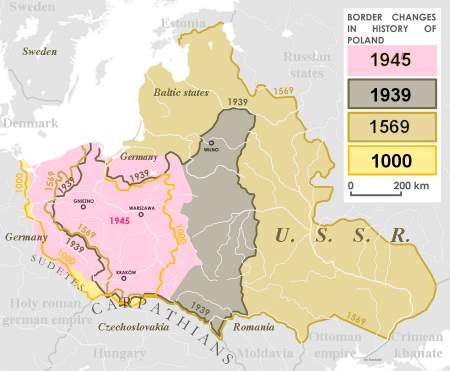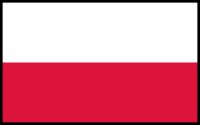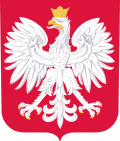
Topographic map of Poland, courtesy 'Captain Blood' at Wikipedia
|
Location and general information Poland with its 38 million inhabitants is a country in Central Eastern Europe and the fifth largest state of European Union. Today it is also a country with very low circumcision rates as compared to Western Europe and especially to the USA. Surprisingly, it looks back on a long tradition of circumcision, as it was home to Europe’s largest Jewish diaspora for several hundred years. Now, within its predominantly (approx. 90%) catholic population, circumcision is still mostly associated with Jewish religion and culture, even though now not many Jews live there. Lately some non-Jewish Poles are beginning to take an interest in circumcision. Poland's varying borders: 1000 - the original Polish state 1569 - the Polish-Lithuanian Commonwealth
1939 - the Second Polish republic |

|

Krakow, Spring 2009. (photo JB)
Jewish Circumcision in Poland
The Polish state was first established in the 10th century by the unification of several Slavic territories. By the 11th century at the latest Jews had begun to settle in Poland, and immigration intensified after the 14th century when they were granted special laws by the Polish Kings. Most of them lived in the Eastern provinces of Poland and in Lithuania (which had a de-facto union with Poland from 1386 and an official union from 1569). While religious Jews practised circumcision, there was no cultural impact of this practice on the majority Christian (Catholic and Orthodox) population.
After a number of annexations by the adjacent states of Prussia, Russia and the Habsburg Monarchy (Austria-Hungary), Poland ceased to exist as an independent state in the year 1795. Some urban Jews wished to assimilate at this time and the Bris was considered an obstacle, so there were suggestions among Jewish activists to abandon it. On the other hand, some Polish Jewish medical doctors counterargued with health advantages.
As a result of World War I, in 1918/1919, Poland (no longer unified with Lithuania) was reinstated as an independent country. In the inter-war years (1918-1939) Poland was probably the European country with the largest population of circumcised males, since there was a Jewish population of 3.1 Million in 1931 and nearly 3.5 Million in 1939. (This exceeds the entire population of Muslim Albania - ed

During World War II Poland was occupied by Nazi Germany. The majority of Polish Jews perished in the Holocaust. In Germany people’s heritage was well documented and Jews were identified based on the official archives. Not so in Poland: in many cases, German soldiers and members of German driven administration tested the penile status of men and boys in the streets, during vaccination procedures or while being taken into custody. They would be send to ghettos, directly to concentration camps, or executed on the spot if they were circumcised. [1] Some skilled Polish and Jewish surgeons secretly attempted some reconstruction procedures to elongate the penile skin ('epispasmus') providing their patients some degree of appearance that they were not circumcised, but these were mostly not very successful.[2]
Entrance to the Auschwitz concentration camp. It is preserved as a memorial to those who died. Image courtesy Wikipedia.
As an outcome of the post-war Potsdam Conference, Poland was shifted westward, giving up Eastern provinces to the Soviet Union but gaining formerly German regions in the west. In the new communist dominated Polish state, more than 95 % of population was Catholic by faith, heritage or tradition. Probably not many more than 150,000 Polish Jews survived WW II, mostly after living in hiding for years. After coming back to their towns, they often discovered that their homes had been taken over by catholic Poles during the war. In the first year after the war 25,000 Jews left Poland. Many other Jews settled in the formerly German cities of Wroclaw (Breslau), Swidnica (Schweidnitz) or Szczecin (Stettin), only to leave some years later (especially in 1968) after experiencing heavy discrimination. Now, there are approx. 6,000 (male and female) members of Jewish cultural organisations in Poland but fewer than 1,500 are observant. Brit milah ceremonies are a rare occurrence.
Circumcision of Lipka-Tatars (Polish Muslims)
Not very well known is another ethnic group which practises circumcision in Poland. With the so-called Tatar invasions in central Europe which began in 1241, Muslim warriors of Mongol and Turkish descent first came to Poland. Smaller groups of them settled in Poland-Lithuania. These Lipka-Tatars were known as fine cavalrymen and maintained their distinct culture mixing Muslim and Eastern Polish influence. While from the 18th century they only used the Polish language, they observed “Siunniet” (as they call the Muslim circumcision ceremony) very rigorously until the mid-20th century.[3]
Circumcision in present day Poland
Today in Poland circumcision is not very popular, but there are no official statistics. However, approx. 13,000-14,000 medical circumcisions (with the male population of 18 million) get refunded by the National Health Fund each year, suggesting a total number of several hundred thousand circumcised non-Jewish Poles [4] (compared to 3,000 Jewish males living in Poland). Since the public health insurance (mandatory for all employees) in Poland is very under-financed and sometimes people must queue for ten, twenty or more months to get a medical procedure, many Polish men make private doctor appointments (meaning they pay for themselves mostly in cash, even though they are insured). [5] This means that official numbers might be a large underestimate and there might be a unknown quota of medical circumcisions not included in official health fund numbers. Obviously there are also men in Poland chosing circumcision for personal reasons. Costs for a privately finances medical or non-medical circumcision are currently 1,000 to 2,500 PLN (250 to 650 USD).[6].
Circumcision is sometimes discussed in mainstream print media. As an interesting contribution to the international debate, in 2008 Jolanta Krawczykiewicz, a female city council member of the north Polish city of Slupsk, proposed introducing routine infant circumcision for all newborn boys in public hospitals in order to fight the spread of human papilloma virus.[7]. This argument spread virally (!) but no serious discussion followed.
In 2013, there was a scandal involving Warsaw Catholic Bishop Hoser and Wojciech Lemanski, a Catholic priest who has shown his symaphty towards Polish Jews many times and is active in fighting antisemitism. Bishop Hoser asked Father Lemanski whether he is circumcised, which makes it obvious that circumcision is still associated with being Jewish in Poland. [8].
In 2017, there was a survey of medical students in Poland about their attitude to circumcision. Surprisingly, students of Polish descent were quite pro both RIC and adult circumcision. And what might be even more surprising, students who declared as atheists were much more pro RIC, so were (perhaps unsurprisingly) female students. [9]. Young Polish doctors seem to be quite pro circumcision. The 2012 German court decision making religious circumcision (briefly) illegal naturally caused discussion in neighbouring Poland, but a 2016 paper [10] came to the conclusion that circumcision by a mohel was entirely legal. It also commented that "in the last years clinics offering male circumcision have been set up, probably as a sign of a trend promoted in some western countries".
References
1. Czesław Kentzer "Rakowiecki" Archiwum historii mówionej, Zasoby muzeum.
2. Maria Ciesielska, “Lekarze wykonujący operacje plastyczne i zabiegi likwidujące skutki obrzezania w Warszawie W Czasie II Wojny Światowej” In: "Cena odwagi: między ocaleniem życia a ocaleniem człowieczeństwa" pp 209-212 Wydawnictwo Naukowe Uniwersytetu Pedagogicznego im. Komisji Edukacji Narodowej w Krakowie, 2019. ISBN 978-83-8084-425-4
3. Agata Nowakowska, “Polish Tatar - customs of national minority from Podlasie region”, Drohiczyński Przegląd Naukowy 6 371, 2014
4. Obrzezanie (Circumcision), at kliniki.pl
5. Czy obrzezanie jest refundowane przez NFZ? (Is circumcision reimbursed by the National Health Fund?), at kliniki.pl
6. Czy warto się obrzezać? (Is Circumcision Worth It?) at kliniki.pl
7. Radna Krawczykiewicz o obrzezaniu (Councillor Krawczykiewicz on circumcision) - YouTube (in Polish)
8. Polish priest's dismissal exposes rift over dialogue with Jews Reuters, 2013.
9. M Korze, M Olszewski, M Ganczak Polish medical students' attitudes regarding male circumcision as a strategy to HIV prevention European Journal of Public Health, 27 suppl_3, 2017
10. K. Banasic, Male circumcision under Polish criminal law Progress in Health Sciences 6(1) pp 201-208, 2016
Article provided by Polish / German contributor Greg

